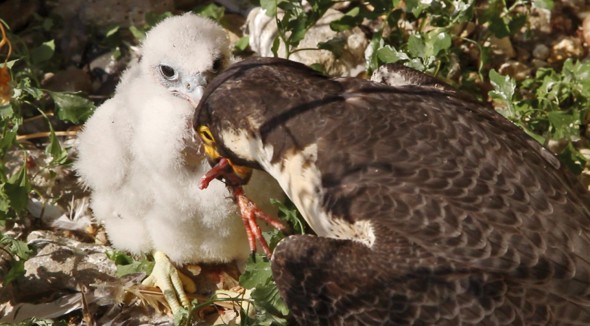UIC’s peregrine falcon family: eating, growing, banding
It’s a grisly sign of spring at UIC: bird heads and feet scattered on the ground outside University Hall. A glance upward might reveal the source: the two peregrine falcons that nest on a ledge outside the 28th floor.
This is the second year that Nitz, the female, and Mouse, a male of unusually small size, are raising chicks up on the administration building. The falcons hunt pigeons and songbirds for food and toss the relatively meatless head aside.
Hunting has ramped up for the falcons since late May, when three of their four eggs hatched. The baby birds, two boys and a girl, are voracious eaters.
Nitz and Mouse established University Hall as their nesting site in 2013 after Nitz pushed out Rosie, an older female falcon who had nested and raised more than 32 chicks on the building since 1999.
While Rosie’s days of raising young are probably over, she was recently sighted in the vicinity.
The new chicks represent the latest chapter in the successful reintroduction of peregrine falcons to the Midwest.
Widespread use of the pesticide DDT thinned the shells of the raptors’ eggs and led to their decline and extirpation east of the Mississippi river in 1951.
In the 1980s, after DDT was banned, naturalists worked to bring the birds back by releasing captive-born chicks in places with plentiful food and nesting sites. University Hall was one of the early release sites; within a few years, peregrines were nesting there and have been raising young on its ledges almost every year.
“Chicago is nothing but a pseudo-cliff along Lake Michigan, and the buildings with their ledges mimic the cliffs the birds nested on before skyscrapers went up,” said Mary Hennen, director of the Chicago Peregrine Program at the Field Museum.
There are now about 27 active nesting sites throughout Illinois — 14 in Chicago.
“There are three pairs downtown in the Loop, a nest in Pilsen, nests in Uptown and Lakeview and on a water intake crib two miles out on Lake Michigan,” said Josh Engel, FIeld Museum research assistant.
Hennen, Engel and team visited University Hall June 13 for an annual ritual: banding the new chicks. “We try to band young from all the nests that are accessible to us — that’s around 12 or 13 spots in the city,” Engel said.

Nitz and Mouse welcomed three baby birds — two boys and a girl — on a ledge of University Hall in late May. The falcons hunt pigeons to feed their young, who are growing and building up to their first flight. Photos: S.K. Vemmer
The birds, about 4 weeks old, are collected from the nest to get leg bands with unique numbers to help researchers and peregrine enthusiasts track them after they fly away.
Over the next few weeks, the chicks will build up the muscles they need to start flying by flapping their wings. Once their long flight feathers come in, they’ll take their first flights — usually short glides down to another building. After they’ve mastered flying, the chicks will begin hunting their own food.
“When the young learn to fly, they stay with their parents for another three weeks or so and when they start doing hunting behaviors on their own, like fly past a tree and pluck off a leaf, the parents start feeding them less and less,” Hennen said.
By the end of the summer, the falcons will leave campus. Some stay in the vicinity of their nest sites, but others have been found as far away as Milwaukee (Nitz’s hometown) and New York.
It’s a safe bet that Nitz and Mouse will return to University Hall to nest and raise another brood next spring, but the chicks must establish their own territories and nests when they reach sexual maturity at age 1 to 2 years.
“Peregrines were removed from the federal endangered species list in large part due to programs like the Chicago Peregrine Program,” Engel said.
“The peregrines have been successful enough that they naturally expanded their populations.”
